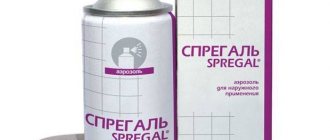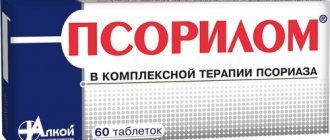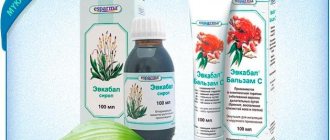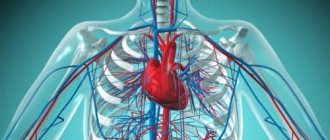Nitromint is a drug (spray) (pharmacological group - drugs for the treatment of heart diseases). Important features from the instructions for use:
How to dissolve vascular plaques, normalize blood circulation, blood pressure and forget the way to the pharmacy
- During pregnancy: contraindicated
- When breastfeeding: contraindicated
- In childhood: contraindicated
- For liver dysfunction: with caution
- If renal function is impaired: with caution
- In old age: possible
Pharmacodynamics and pharmacokinetics
Pharmacodynamics
Nitroglycerin is a nitrogen-containing compound, a peripheral vasodilator with venodilating and antianginal effects .
The action of nitroglycerin is associated with the ability to release nitric oxide, which affects the endothelium, causing smooth muscle relaxation and vasodilation. As a result, preload (venous return) and afterload (resistance of the systemic vessels) are reduced. The load on the heart is reduced and the need for oxygen is reduced.
The simultaneous expansion of the coronary vessels significantly increases the delivery of oxygen to the heart muscle. A decrease in venous return leads to a decrease in pressure in the pulmonary circle, a decrease in the volume of the left ventricle and eliminates pulmonary edema .
Relaxes the smooth muscles of the gallbladder and ducts, bronchi, urinary tract, and intestines. The effect of the drug begins in 30-60 seconds and lasts from 10 to 30 minutes.
Pharmacokinetics
The aerosol is quickly absorbed from the oral cavity. Bioavailability 100%. Cmax in the blood is determined after 4 minutes. 60% binds to blood proteins. Binds to red blood cells.
Metabolized to form mononitrates and dinitrates. Metabolites are excreted by the kidneys. T1/2 is 2.5–4.5 minutes.
Bottom line
The medicine can reduce high blood pressure levels and normalize the patient’s condition in a few minutes. The feeling of heat caused by the medicine disappears in a short time. Sometimes patients complain of a severe headache that occurs after an attack and taking the drug.
The drug helps relieve heart pain. Before starting physical activity, patients with cardiac pathologies should use Nitromint. The spray also has good reviews from doctors. Experts say that the medicine can serve as an excellent prevention of attacks. However, medications are only an auxiliary measure. Patients who have problems with the cardiovascular system should lead a normal lifestyle, avoid excessive physical activity, and give up nicotine and alcohol. This is the only way to prolong life.
Contraindications
- shock;
- collaptoid states;
- increased sensitivity to nitrates;
- age up to 18 years.
Prescribed with caution for orthostatic hypotension , acute circulatory failure with blood pressure below 90 mm Hg. Art., hypertrophic cardiomyopathy , hemorrhagic stroke , severe renal and liver failure , anemia , epilepsy , acute myocardial infarction with a low degree of filling of the left ventricle, thyrotoxicosis , alcoholism, head injury, angle-closure glaucoma , migraine .
Nitromint spray sublingual dosage 0.4 mg/dose 180 doses balloon 10g 12376
Description
Colorless or almost colorless transparent solution without sediment. Nitromint® aerosol is quickly and completely absorbed from the oral cavity into the systemic circulation. The bioavailability of the drug Nitromint® is 100% when taken sublingually, because primary hepatic degradation of the drug is excluded. Cmax in blood plasma is reached after 4 minutes. The connection with blood plasma proteins is 60%. It is quickly metabolized with the participation of nitrate reductase, with the formation of di- and mononitrates (only isosorbide-5-mononitrate is active), the final metabolite is glycerol. Excreted by the kidneys in the form of metabolites. The total clearance is 25–30 l/min. After taking the drug sublingually, T1/2 from blood plasma is 2.5–4.4 minutes. Circulating nitroglycerin is tightly bound to red blood cells and accumulates in the walls of blood vessels. The main route of elimination of nitroglycerin is excretion of metabolites in the urine; less than 1% of the administered dose is excreted unchanged. Nitroglycerin is an organic nitrogen-containing compound with a predominant venodilating effect. The effects of nitroglycerin are due to its ability to release nitric oxide from its molecule, which is a natural endothelial relaxing factor. Nitric oxide increases the intracellular concentration of cGMP, which prevents the penetration of calcium ions into smooth muscle cells and causes them to relax. Relaxation of the smooth muscles of the vascular wall causes vasodilation, which reduces venous return to the heart (preload) and vascular resistance in the systemic circulation (afterload). This reduces the work of the heart and the myocardium's need for oxygen. Dilatation of coronary vessels improves coronary blood flow and promotes its redistribution to areas with reduced blood circulation, which increases oxygen delivery to the myocardium. A decrease in venous return leads to a decrease in filling pressure, improved blood supply to the subendocardial layers, a decrease in pressure in the pulmonary circulation and regression of symptoms of pulmonary edema. Nitroglycerin has a central inhibitory effect on the sympathetic tone of blood vessels, inhibiting the vascular component of the formation of pain. Nitroglycerin also relaxes the smooth muscle cells of the bronchi, urinary tract, gallbladder, bile ducts, esophagus, small and large intestines, as well as their sphincters. The action of Nitromint® begins quickly, the effect develops within 1–1.5 minutes and lasts approximately 30 minutes. Nitromint® enhances the excretion of catecholamines and vanillinmandelic acid in the urine. The consumption of alcoholic beverages while using the drug is strictly prohibited. Impact on the ability to drive a car or perform work that requires increased speed of physical and mental reactions. At the beginning of treatment, it is necessary to refrain from driving vehicles and engaging in potentially hazardous activities that require increased concentration and speed of psychomotor reactions. In the future, the degree of restrictions is determined individually for each patient.
Compound
Sublingual dosed aerosol 1 balloon active substance: nitroglycerin 0.08 g (in the form of 1% (m/m) solution) excipients: ethanol (96%) - 7.92 g; propylene glycol - 2 g in aluminum aerosol cans with a dosing device, containing 10 g of solution (180 doses of 0.4 mg/dose); 1 cylinder in a cardboard pack.
Application
angina pectoris (relief and prevention of attacks, including before physical activity); acute left ventricular failure (as an auxiliary therapy). The excretion of nitroglycerin into breast milk has not been established. The use of Nitromint® during pregnancy and breastfeeding requires careful comparison of risks and benefits and should be carried out under strict medical supervision. From the cardiovascular system: dizziness, headache, tachycardia, fever, decreased blood pressure; rarely (especially in case of overdose) - orthostatic collapse, cyanosis. From the digestive system: dry mouth; rarely - nausea, vomiting, abdominal pain. From the side of the central nervous system: weakness; rarely - anxiety, psychotic reactions, lethargy, disorientation. Allergic reactions: rarely - skin rash, itching. Local reactions: skin hyperemia, burning sensation under the tongue. Other: rarely - blurred vision, hypothermia, methemoglobinemia. Other vasodilators and antihypertensive drugs (beta-blockers, CCBs), ACE inhibitors, antipsychotics, tricyclic antidepressants, MAO inhibitors, phosphodiesterase inhibitors, procainamide and ethanol may enhance the hypotensive effect of Nitromint®. Nitromint® enhances the effect of dihydroergotamine and reduces the effectiveness of heparin. Sublingual. Before using the canister for the first time, fill the dosing pump by removing the protective cap and pressing the dosing valve several times until an aerosol appears. After a long period of not using the cylinder, it may be necessary to refill the pump. When using, the can should be held vertically with the spray head facing up. Each press of the dosing valve releases 1 dose (0.4 mg of nitroglycerin) as an aerosol from a canister equipped with a mechanical pump. There is no need to shake the container before use. To relieve an attack of angina: 0.4–0.8 mg (1–2 doses), pressing the dosing valve, preferably in the “sitting” position, while holding your breath at intervals of 30 s; After this, you should close your mouth for a few seconds. If necessary, repeat administration, but not more than 1.2 mg (3 doses) over 15 minutes. To prevent the development of an attack - 0.4 mg (1 dose) 5-10 minutes before exercise. In case of acute left ventricular failure, developing pulmonary edema: 1.6 mg (4 doses) or more in a short period of time with strict control of the circulatory condition (SBP should be >100 mm Hg). If the therapeutic effect is insufficient, the same dose can be repeated after 10 minutes. No change in dosage regimen is required when using the drug in elderly patients. Symptoms: headache, decreased blood pressure, orthostatic hypotension, reflex tachycardia, dizziness, facial flushing, vomiting and diarrhea, asthenia, increased drowsiness, feeling hot. Extremely high doses (more than 20 mg/kg) lead to methemoglobinemia, cyanosis, dyspnea and tachypnea, and orthostatic collapse. Treatment: in mild cases, transfer the patient to a lying position with legs elevated. In case of severe overdose, general methods of treatment of intoxication and shock should be used (replenishment of blood volume, administration of norepinephrine and/or dopamine, etc.). The use of epinephrine is contraindicated. With the development of methemoglobinemia, the following antidotes and treatment methods can be used: 1. Vitamin C in a dose of 1 g in the form of sodium salt orally or intravenously. 2. IV methylene blue in a dose of up to 50 ml of a 1% solution. 3. Toluidine blue IV, first dose 2–4 mg/kg, then multiple doses of 2 mg/kg. 4. Oxygen therapy, hemodialysis, blood transfusion (exchange). hypersensitivity to organic nitrates; shock; collapse; age under 18 years (lack of sufficient clinical data). With caution: acute circulatory failure accompanied by severe arterial hypotension (SBP below 90 mm Hg), orthostatic hypotension, hemorrhagic stroke, acute myocardial infarction and chronic heart failure with low left ventricular filling pressure, hypertrophic cardiomyopathy, severe renal and/or liver failure, severe anemia and thyrotoxicosis, alcoholism, epilepsy, head injury, intracranial hypertension, angle-closure glaucoma (risk of increased intraocular pressure), migraine.
Possible product names
- Nitromint aeros oral 72mg 180dz fl 10g N1
- NITROMINT 0.4 MG/DOSE SPRAY 180 DOSES 10.0
- NITROMINT 400MCG/DOSE 180 DOSES AEROSOL
- NITROMINT AEROSIS. LIFT DOS. 0.4 MG/DOSE 10 G. (180 DOSE) X1
- NITROMINT AER. SUBLINGUAL DOSAGE. 0.4MG/DOSE 180DOSES 10G No.1
- NITROMINT 0.4MG/DOSE AEROSOL SUBLANGUS DOSE. 180DOZ (10G) (R)
Instructions for use of Nitromint (Method and dosage)
The drug is sprayed under the tongue while holding the breath. Before first use, you need to fill the pump by pressing the valve until an aerosol appears. If the cylinder is not used often, the pump needs to be refilled.
When spraying the drug, the container is held vertically, head up. One click on the valve corresponds to 1 dose - 0.4 mg of nitroglycerin . There is no need to shake the container before use.
Aerosol Nitromint, instructions for use
During an attack of angina, the spray is sprayed in an amount of 1–2 doses (0.4–0.8 mg) in a sitting position, at intervals of 30 s. Then you need to close your mouth. Repeated administration - up to 3 doses in 15 minutes.
To prevent an attack, use 1 dose 10 minutes before exercise.
For pulmonary edema and left ventricular failure, use 4 doses or more in a short time, controlling blood pressure (systolic>100 mmHg).
In elderly people, the dosage regimen does not change.
Dosage
Dose selection is carried out individually for each patient and depends on clinical symptoms, severity of the process and sensitivity to the drug. Cardiologists say that an attack of angina can be stopped by administering one or two doses of medication under the tongue. After 15 minutes, you can repeat the administration of the drug. To avoid an attack during physical activity, one dose of the drug should be administered a few minutes before it. Each squeeze of the spray dispenses one dose of medication. The aerosol head should be at the top and the can itself should be in a vertical position.
Overdose
Overdose is manifested by symptoms: orthostatic hypotension , headache, sharp decrease in blood pressure, tachycardia , dizziness, vomiting, drowsiness, facial flushing, feeling of heat.
When taking high doses (20 mg/kg or more), methemoglobinemia , dyspnea , cyanosis , and collapse . Treatment: lay the patient down, placing the legs in an elevated position. In severe cases - administration of norepinephrine , replenishment of blood volume. Epinephrine is contraindicated.
Overdose of the drug Nitromint, symptoms and treatment
Symptoms: headache, severe arterial hypotension, tachycardia, dizziness, hot flashes, vomiting, diarrhea, methemoglobinemia. In case of excessive overdose, cyanosis, dyspnea and tachypnea and changes in blood counts (methemoglobinemia) may occur. Treatment: for collapse, intravenous infusion of 0.9% sodium chloride solution, norepinephrine and/or dopamine is indicated. For methemoglobinemia:
- intravenous administration of methylene blue (maximum 50 ml of 1% solution); ascorbic acid intravenously - 1 g in the form of a solution of sodium salt of ascorbic acid or in the form of tablets - 1 g orally;
- toluidine blue at an initial dose of 2–4 mg/kg body weight intravenously, then 2 mg/kg again;
- oxygen therapy, hemodialysis, blood transfusion, blood transfusion.
Interaction
Vasodilators , ACE inhibitors , beta-blockers , CCBs , antipsychotics , antidepressants , MAO inhibitors , Procainamide and phosphodiesterase inhibitors enhance the hypotensive effect of the drug.
Simultaneous administration of ACC and ethanol enhances the vasodilating effect.
Nitromint enhances the effect of the antiadrenergic drug Dihydroergotamine and reduces the effects of Heparin .
Analogs
Level 4 ATC code matches:
Nitrospray
Nitroglycerine
Efox
Monosan
Pectrol
Isoket
Erinite
Cardiket
Sustak Forte
Nitrosorbide
nitroglycerin preparations in tablets (regular and extended-release), in the form of spray, aerosol, ointment, transdermal patches and films for gluing to the gums: Nitroglycerin , Sustak , Sustonit , Nitrong , Nitroderm , Gluconit , Deponit 10 , Nitrocor , Nirmin , Nit-ret , Perlinganite , Trinitrolong, Nitradisk , Nitrospray-ICN , Nitrospray , Nitro , Nitrosprint .
Reviews
Nitroglycerin in tablet form may not give the desired effect in a critical situation. When compared with sublingual tablets, the use of an aerosol is more effective - the onset of action is accelerated, the antianginal effect is more pronounced and the duration of an angina . In this connection, the drug in this release form is suitable for providing “first aid”. A number of patients prefer the aerosol form due to its ease of use.
There are negative reviews that are associated with the presence of adverse reactions. Nitromint spray, like all nitrates , causes a pulsating headache that lasts from 15 minutes to several hours in some patients. In elderly patients it is accompanied by dizziness. The occurrence of headache is noted after the first doses of the drug. It is more often observed when using long-acting drugs.
In order to reduce this side effect, it is recommended to use drugs with menthol (for example, Validol ) or NSAIDs ( Acetylsalicylic acid , Paracetamol ) together. Side effects such as heartburn , nausea and vomiting are much less common.
How to take the drug?
The drug is prescribed for spraying under the tongue. While administering the dose, you should hold your breath and breathe through your nose. You can take two doses at once, 45 seconds apart. It is not allowed to use more than three doses within an hour. When repeated administration, it is necessary to monitor pressure readings. The maximum permissible dosage per day is 4 doses.
Side effects in case of overdose are as follows:
- reflex tachycardia;
- facial redness;
- feeling of heat;
- decreased blood pressure;
- collapse;
- dizziness;
- migraine;
- loss of consciousness;
- sleep disturbance;
- epigastric pain;
- nausea;
- vomit;
- diarrhea;
- allergic reactions.
Identical side effects may develop if Nitromint (spray) is taken in higher dosages. The analogues are very similar.
Nitromint price, where to buy
You can buy it in many pharmacies in Moscow and other cities.
The price of Nitromint spray 10 g (180 doses) ranges from 149 rubles. up to 170 rub.
- Online pharmacies in RussiaRussia
- Online pharmacies in UkraineUkraine
- Online pharmacies in KazakhstanKazakhstan
Pharmacy Dialogue
- Nitromint (spray 180 doses) Egis
139 rub. order
show more
Pharmacy24
- Nitromint 0.4 mg/dose 10 g aerosol ZAT FZ EGIS/VAT Pharmaceutical plant EGIS, Ugorshchina/Ugorshchina
99 UAH.order
PaniPharmacy
- Nitromint aerosol Nitromint aer. 1% 10g Hungary, Egis
132 UAH order
show more
Timely assistance is the key to success!
There are medications that can dilate the coronary vessels in a short time and alleviate the patient’s condition. These medications can be used until the ambulance arrives. Such drugs include Nitromint (spray). Its analogue “Izo Mik” is also widely used. The medications have identical composition and indications for use and belong to the same group of antianginal drugs. The dosage of the medicine may depend on the severity of the heart attack. Experts say that Nitromint can become a reliable assistant for people who have cardiovascular pathologies.









